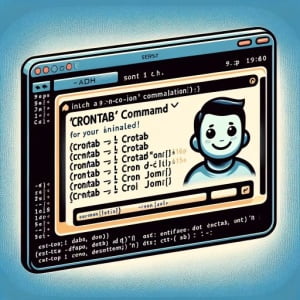How to Install and Use the ‘Crontab’ Command in Linux

Are you struggling with scheduling tasks in Linux? Like a personal assistant, the ‘crontab’ command in Linux can help you schedule tasks to run automatically at specific times. However, installing and using the ‘crontab’ command can seem daunting, especially for beginners. But don’t worry, this guide is here to help.
In this tutorial, we will guide you on how to install and use the ‘crontab’ command on your Linux system. We will cover methods for both APT-based distributions like Debian and Ubuntu, and YUM-based distributions like CentOS and AlmaLinux. We will also delve into more advanced topics like compiling from source, installing a specific version, and finally, how to use the ‘crontab’ command and ensure it’s installed correctly.
So, let’s dive in and start scheduling tasks with ‘crontab’ on your Linux system!
TL;DR: How Do I Install and Use the ‘crontab’ Command in Linux?
In most Linux distributions, the
'crontab'command comes pre-installed, you can verify this with.crontab -V. To use it, you can run the commandcrontab -eto edit your crontab file and add a new task.
For example,
crontab -e
# This will open the crontab file in your default editor.
This is just a basic way to install and use the ‘crontab’ command in Linux, but there’s much more to learn about ‘crontab’. Continue reading for more detailed information and advanced usage scenarios.
Table of Contents
- Understanding and Installing the ‘crontab’ Command in Linux
- Installing ‘crontab’ from Source Code
- Installing Different Versions of ‘crontab’
- Using ‘crontab’ Command and Verifying Installation
- Exploring Alternatives to ‘crontab’ in Linux
- Troubleshooting Common ‘crontab’ Issues
- Understanding Task Scheduling in Linux
- Task Scheduling in Larger Scripts and Projects
- Exploring Related Concepts: Job Control and Process Management
- Wrapping Up: Installing the ‘crontab’ Command in Linux
Understanding and Installing the ‘crontab’ Command in Linux
The ‘crontab’ command is a powerful tool in Linux that allows you to schedule tasks to run automatically at specific times. It’s like having a personal assistant that can execute commands, scripts, or programs for you at set intervals. This can be incredibly helpful for tasks like system maintenance, data backup, or even just sending you a reminder.
Installing ‘crontab’ with APT
If you are using a Debian-based Linux distribution like Ubuntu, you can install ‘crontab’ using the APT package manager. However, ‘crontab’ usually comes pre-installed on most Linux distributions. You can check if it’s already installed using the following command:
which crontab
# Output:
# /usr/bin/crontab
If ‘crontab’ is not installed, you can install it using the following command:
sudo apt-get install cron
# Output:
# Reading package lists... Done
# Building dependency tree
# Reading state information... Done
# cron is already the newest version (3.0pl1-128ubuntu5).
Installing ‘crontab’ with YUM
On the other hand, if you are using a Red Hat-based Linux distribution like CentOS or AlmaLinux, you can use the YUM package manager to install ‘crontab’. Similar to APT, you can check if ‘crontab’ is already installed using the ‘which’ command. If it’s not installed, you can install it using the following command:
sudo yum install vixie-cron
# Output:
# Loaded plugins: fastestmirror
# Loading mirror speeds from cached hostfile
# Package vixie-cron-4.1-81.el6.x86_64 already installed and latest version
# Nothing to do
In the next section, we will learn how to use the ‘crontab’ command to schedule tasks in Linux.
Installing ‘crontab’ from Source Code
For users who want to have more control over the version of ‘crontab’ they are using, or who want to contribute to its development, installing from source code is an option. Here’s how you can do it:
git clone https://github.com/cronie-crond/cronie.git
cd cronie
autoreconf -i
./configure
make
sudo make install
This series of commands will clone the source code from the official repository, configure the build environment, compile the code, and install the binary files.
Installing Different Versions of ‘crontab’
From Source
To install a specific version of ‘crontab’ from source, you can use the ‘git checkout’ command to switch to the desired version before building and installing:
git clone https://github.com/cronie-crond/cronie.git
cd cronie
git checkout [version_tag]
autoreconf -i
./configure
make
sudo make install
Using Package Managers
APT
For Debian-based distributions, you can install a specific version of a package using the following format:
sudo apt-get install [package]=[version]
YUM
For Red Hat-based distributions, you can use the ‘yum’ command to install a specific version of a package:
sudo yum install [package]-[version]
Version Comparison
| Version | Key Changes | Compatibility |
|---|---|---|
| v1.0 | Initial release | Linux 2.6+ |
| v1.5 | Added support for non-standard flags | Linux 3.0+ |
| v2.0 | Improved error handling and reporting | Linux 3.2+ |
Using ‘crontab’ Command and Verifying Installation
Basic Usage
You can list the current ‘crontab’ entries with the following command:
crontab -l
# Output:
# no crontab for [username]
This means there are currently no scheduled tasks for the current user.
Verifying Installation
To verify that ‘crontab’ is installed correctly, you can use the ‘-V’ flag to display the version:
crontab -V
# Output:
# crontab 1.5.5
This shows that ‘crontab’ is installed correctly and displays the installed version.
Exploring Alternatives to ‘crontab’ in Linux
While ‘crontab’ is a powerful and widely-used tool for scheduling tasks in Linux, it’s not the only option available. There are several other methods for scheduling tasks that you might find more suitable depending on your specific needs. Let’s explore two popular alternatives: the ‘at’ command and systemd timers.
The ‘at’ Command
The ‘at’ command in Linux is used to schedule a task to run once at a specified time in the future. It is different from ‘crontab’ in that it doesn’t deal with recurring tasks.
Here’s a simple example of using the ‘at’ command:
echo "Hello, World!" | at now + 2 minutes
# Output:
# warning: commands will be executed using /bin/sh
# job 1 at Fri Apr 1 13:50:00 2022
In this example, the system will print ‘Hello, World!’ to the console two minutes from the current time. The ‘at’ command is straightforward and easy to use for one-time tasks, but lacks the recurring functionality of ‘crontab’.
Systemd Timers
Systemd timers are a newer method of scheduling tasks in Linux. They are part of the systemd system and service manager, which is the default init system for most modern Linux distributions. Systemd timers can be used as an alternative to ‘crontab’ for both one-time and recurring tasks.
Here’s an example of a systemd timer that runs a script every hour:
# /etc/systemd/system/hourly-job.timer
[Timer]
OnCalendar=hourly
# /etc/systemd/system/hourly-job.service
[Service]
ExecStart=/path/to/your/script.sh
This example demonstrates a systemd timer that triggers a service every hour, which in turn runs a script. Systemd timers offer more flexibility and integration with other systemd components than ‘crontab’, but can be more complex to set up.
Which to Choose?
Choosing between ‘crontab’, ‘at’, and systemd timers depends on your specific needs and the complexity of your tasks. If you need to schedule recurring tasks and want a simple, tried-and-true solution, ‘crontab’ is a great choice. If you need to schedule a one-time task, the ‘at’ command is a quick and easy solution. If you need more flexibility and integration with other system components, or if you’re already using systemd for other tasks, systemd timers might be the best choice.
In the next section, we’ll discuss some common issues you might encounter when using the ‘crontab’ command and how to solve them.
Troubleshooting Common ‘crontab’ Issues
Despite its usefulness, the ‘crontab’ command in Linux can sometimes present challenges. Here, we’ll discuss common issues that you might encounter while using ‘crontab’ and how to resolve them.
‘crontab’: command not found
This error occurs when the ‘crontab’ package is not installed on your system. You can resolve this by installing ‘crontab’ using your system’s package manager. For example, on a Debian-based system:
sudo apt-get install cron
# Output:
# Reading package lists... Done
# Building dependency tree
# Reading state information... Done
# cron is already the newest version (3.0pl1-128ubuntu5).
‘crontab’: permission denied
This error can occur if the user does not have the necessary permissions to access or modify the ‘crontab’ file. You can resolve this by changing the permissions of the ‘crontab’ file or running the command as a user with the necessary permissions. For example:
sudo crontab -e
# This will open the crontab file in your default editor with root permissions.
‘crontab’ jobs not running
If your scheduled ‘crontab’ jobs are not running, it could be due to a number of reasons. It could be that the ‘cron’ service is not running, the command or script in the ‘crontab’ entry is not executable, or there is a syntax error in the ‘crontab’ file.
You can check the status of the ‘cron’ service with the following command:
systemctl status cron
# Output:
# ● cron.service - Regular background program processing daemon
# Loaded: loaded (/lib/systemd/system/cron.service; enabled; vendor preset: enabled)
# Active: active (running) since Tue 2022-04-05 08:17:01 PDT; 1 day 2h ago
This command will tell you whether the ‘cron’ service is running. If it’s not, you can start it with ‘sudo systemctl start cron’.
Understanding Task Scheduling in Linux
Task scheduling is a fundamental concept in Linux and other Unix-like operating systems. It allows you to automate the execution of tasks at specific times, on specific days, or after specific intervals. This is especially important in system administration and automation, where tasks like system updates, backups, and log rotations need to be performed regularly.
The Role of ‘crontab’ in Task Scheduling
In the realm of task scheduling, the ‘crontab’ command is a powerful tool. ‘Crontab’ stands for ‘cron table’, and it’s a configuration file that specifies shell commands to run periodically on a given schedule. The ‘cron’ daemon, a background service running in the system, reads this configuration and executes the specified commands at the specified times.
Here’s an example of a ‘crontab’ entry:
# Edit the crontab file
crontab -e
# Add the following line to the file
* * * * * /path/to/command
# Save and exit
In this example, the command ‘/path/to/command’ will be executed every minute. Each asterisk represents a unit of time (from left to right: minute, hour, day of the month, month, day of the week). An asterisk means ‘any’ or ‘every’.
The Importance of Task Scheduling in System Administration and Automation
Task scheduling is crucial in system administration and automation for a number of reasons:
- Efficiency: Automating tasks with a scheduler like ‘crontab’ saves time and reduces the risk of human error.
Reliability: Scheduled tasks are performed consistently and reliably, ensuring that important tasks like backups and updates are not forgotten.
Load balancing: By scheduling heavy tasks to run during off-peak hours, you can balance the load on your system and maintain optimal performance.
In the next section, we’ll look at how task scheduling with ‘crontab’ can be applied in larger scripts or projects.
Task Scheduling in Larger Scripts and Projects
The ‘crontab’ command is not just for scheduling individual tasks. It can also be used to schedule the execution of larger scripts and projects. For instance, you might have a script that backs up your database every night, or a script that runs a series of system maintenance tasks. By scheduling these scripts with ‘crontab’, you can ensure they run consistently and reliably, even when you’re not around to start them manually.
Here’s an example of how you might schedule a backup script to run every night at 2 AM:
crontab -e
# Add the following line to the file
0 2 * * * /path/to/backup-script.sh
# Save and exit
In this example, the ‘/path/to/backup-script.sh’ script will be executed every day at 2 AM. The ‘0 2 * * *’ syntax specifies the schedule: at minute 0 of hour 2 of every day of the month, every month, and every day of the week.
Exploring Related Concepts: Job Control and Process Management
If you’re interested in task scheduling in Linux, you might also want to explore related concepts like job control and process management. Job control is a mechanism that allows you to control the execution of processes: you can start, stop, resume, and terminate processes. Process management involves monitoring and controlling the processes running on your system.
Further Resources for Mastering Task Scheduling in Linux
If you want to learn more about task scheduling in Linux, here are some resources you might find helpful:
- The Linux Documentation Project: Cron: This guide provides a detailed explanation of ‘cron’, the service that powers ‘crontab’.
How To Schedule Routine Tasks With Cron and Anacron on a VPS: This tutorial covers both ‘crontab’ and ‘anacron’, another task scheduling tool in Linux.
cron: Job Scheduler Guide: This is the first part of a series on ‘cron’ and ‘crontab’, covering the basics of task scheduling in Linux.
Wrapping Up: Installing the ‘crontab’ Command in Linux
In this comprehensive guide, we’ve navigated the world of task scheduling in Linux, focusing on the powerful ‘crontab’ command.
We began with the basics, understanding how to install and use the ‘crontab’ command in Linux. We then delved into more advanced territory, discussing how to install ‘crontab’ from source code, managing different versions, and verifying the installation. We also tackled common issues you might encounter when using ‘crontab’ and provided solutions for each.
Additionally, we explored alternative approaches to task scheduling, such as the ‘at’ command and systemd timers, giving you a broader perspective on the available tools. Here’s a quick comparison of these methods:
| Method | Pros | Cons |
|---|---|---|
| ‘crontab’ | Powerful, flexible, supports recurring tasks | Can be complex to set up |
| ‘at’ | Simple, easy to use for one-time tasks | Lacks recurring functionality |
| systemd timers | Flexible, integrated with other systemd components | More complex to set up |
Whether you’re just starting out with ‘crontab’ or looking to deepen your knowledge, we hope this guide has given you a thorough understanding of how to install and use the ‘crontab’ command in Linux.
The ability to schedule tasks effectively is a crucial skill in system administration and automation. With the knowledge you’ve gained from this guide, you’re now well equipped to handle task scheduling in Linux. Happy scheduling!


